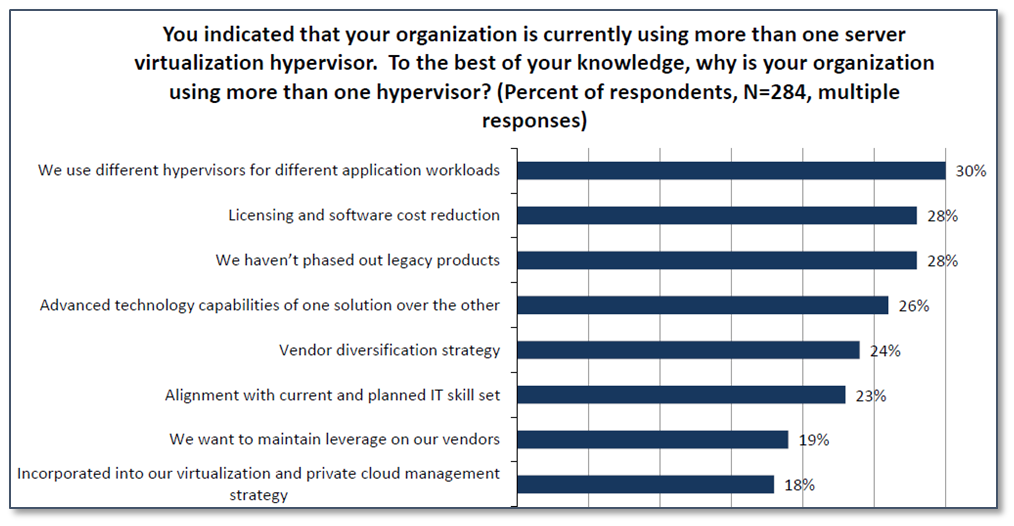Research: Multi-Hypervisor Usage Shows Need for Consolidated Heterogeneous Management Solution
I’m seeing an interesting trend taking hold in organizations, which is the increasing implementation of multiple hypervisors within IT infrastructures. The reasons you, as decision makers in IT, typically cite for adopting this heterogeneous approach vary. They often include the desire to support your different application workloads, reduce your licensing and software costs, and your interest in vendor diversification, to name a few. I saw a recent example of customer feedback on hypervisor diversification in a blog post from Chris Wolf of Gartner, where he notes that during a poll of the audience at the Gartner Data Center conference in Las Vegas, 29% of the attendees indicated that they had no plans to use a single hypervisor for production server applications that require Disaster Recovery and instead would use the best-of-breed solution for each scenario.
Additionally, I was reading a blog post last week by Mark Bowker, a Senior Analyst with Enterprise Strategy Group (ESG), regarding a recent Research Brief summarizing results of ESG’s survey of IT Decision Makers. This survey data showed that nearly two thirds (65%) of respondent organizations reported using more than one hypervisor. ESG’s research also showed that of the 35% of respondents that were still using a single hypervisor, nearly half (49%) planned to add an additional hypervisor within the next 12-18 months.
In his post, Mr. Bowker says, “…the majority of scenarios I see are IT maintaining their investment in its primary platform for the time being and starting to onboard an additional hypervisor for different application workloads, licensing/ cost reduction--by phasing out legacy products--or for the advanced technology capabilities of one solution over the other.”
An illustration of why organizations choose to use more than one hypervisor can be found in the graphic below from the Research Brief:
I’m not particularly surprised by this trend. As many of our customers are investigating alternatives to their existing virtualization technology for reasons like high cost or fear of vendor lock-in, I’m seeing a great deal of customer interest in implementing Windows Server 2012 and Hyper-V to take advantage of its compelling new features like network virtualization and Storage Spaces. The feedback from independent Press and Reviewers has been extremely positive as well: CRN named Windows Server 2012 a product of the year for its improvements in virtualization, networking, and management that increase the speed, scale, and power of customers’ datacenters and applications.
So while not surprising, this trend of multiple hypervisor deployments does elevate your need for a single management solution which can manage across your heterogeneous virtualization environments and reduce your management tools complexity, redundancy and costs.
The ESG Research Brief supports this by stating, “ Progressive server virtualization users, on the other hand, are likely to look further up the IT stack at how to manage a multi-hypervisor approach by enabling visibility, provisioning, and monitoring from a centralized management tool.”
The other reality is that there are very few of you in IT who have implemented a fully virtualized environment today. Many of you still have physical servers and a variety of applications running on those servers—not to mention your user desktop environments—all of which need to be managed. I also know many of you are also already implementing and taking advantage of the benefits that the cloud – including our Windows Azure service—has to offer. This IT mix of physical, virtual, desktop, server, on-premise, and cloud can certainly present challenges if not properly managed.
As you look across your current, expanding and future IT environment are you asking yourself, “Do I have the right set of management tools to address my needs today and in the future?”
Many of our customers have asked themselves and their organizations similar questions and have found the solution by implementing System Center 2012. With System Center, customers can manage across their physical and virtual IT environments, as well as externally to their cloud-hosted environments and applications. Some of these examples include the following:
- Unilever (UK) - Unilever used Hyper-V and Microsoft System Center 2012 to create a private cloud environment that contains 3,175 virtual machines and will deliver IT services 40 percent faster and be more agile in the marketplace.
- Menzies Aviation - Using System Center 2012 for virtual machine management will help the company become even more scalable and agile. “If we need six virtual machines right now, it’s not a problem,” says Alan Yin, System Engineer, Enterprise Systems Team, Menzies Aviation. “With System Center 2012, this can be done in minutes, rather than the traditional way of building servers, which would take half a day each.”
- ABM - By taking advantage of management efficiencies in Windows Server 2012 and System Center 2012 Configuration Manager, the ABM IT staff can spend its time on higher-value tasks that deliver more value to the business.
These customers and many more are making the investment today in System Center 2012 and Windows Server 2012 Hyper-V to ensure they can properly manage across their IT environments today, lay the foundation for their Private Cloud environments, while also preparing for the evolution of IT to Hybrid and Public Cloud environments. With Microsoft’s Cloud OS strategy, customers can see how Microsoft is there to help them today and provides the technology assets they need to move forward at their pace.
If you’re interested in a consolidated way of managing your heterogeneous and complex IT environment, take a look at the trial download of Microsoft’s Private Cloud offering consisting of System Center 2012 and Windows Server 2012. You can also see a good over of the Microsoft Cloud OS strategy in the video with Satya Nadella, our division president, where he talks about the value that Microsoft can deliver today for your on-premise datacenter and Private Cloud through Public Cloud needs.
Thanks for reading and your time - Larry
